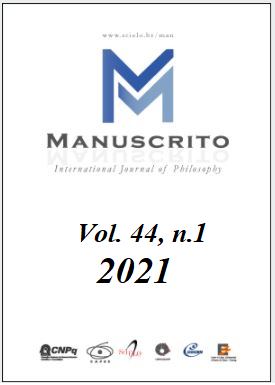Resumo
In the present paper we study the relationship between the notions of force, cause and subject of motion in Leibniz’s early dynamics. First, we specify the role that the problem of the subject and cause of motion played in the development of his dynamics. Second, we analyze the distinction between force and quantity of motion and the validity and limits of his proof. Third, we study and evaluate the limits of the arguments for establishing that forces are inherent to bodies. Our main goal is to show that between 1678 and 1686 Leibniz dissociates the problem of the subject from the problem of the cause of motion and, furthermore, that even though the problem of establishing that force is inherent to particular bodies played a major role in the discovery of his dynamics, it has no place in its justification.
Referências
ANTOGNAZZA, M., Leibniz. An Intellectual Biography, Cambridge, Cambridge Universit Press, 2009.
BELAVAL, Y. Etudes leibniziennes, Paris, Gallimard, 1976.
BERNSTEIN, H. “Leibniz and Huygens on the ‘Relativity’ of Motion”, in: Studia Leibnitiana, 13: pp. 97–113, 1984.
BROWN, G, “Quod ostendendum susceperamus: What did Leibniz undertake to Show in the Brevis Demonstratio?”, in: Studia Leibnitiana Sonderhefte, 13: pp. 122-137, 1984.
COSTABEL, P. Leibniz et la dynamique. Le texte de 1962, Paris, Hermann, 1981 DUCHESNEAU, F. La dynamique de Leibniz, Paris, Vrin, 1994.
DUGAS, R., Histoire de la mécanique, Neuchatel, Griffon, 1950. FICHANT, M. “La ‘réforme’ leibnizienne de la dynamique, d’après des textes inédits », in : Akten des II. Internationaler Leibniz-Kongresses, Bd. II, Studia Leibnitiana Supplementa, 13: 195-214, 1974.
GALE, G. “The Concept of Force and its Role in the Genesis of Leibniz’ Dynamical Viewpoint”, in: Journal of the History of Philosophy, 26 (1): pp. 45-67, 1988.
GARBER, D. Leibniz: Body, Substance, Monad, Oxford, Oxford University Press, 2009.
GUEROULT, M. Dynamique et métaphysique leibniziennes, Paris, Belles Lettres, 1934.
HANNEQUIN, A. “La première philosophie de Leibniz”, in A. HANNEQUIN. Etudes d’histoire des sciences et d’histoire de la philosophie, Paris, Alcan, 1909.
HOFMANN, J. Leibniz in Paris 1972-1976. His Growth to Mathematical Maturity, Cambridge, Cambridge University Press, 1974.
ILTIS, C. “Leibniz and the Vis Viva Controversy”, Isis, 62: pp. 21-35, 1971.
JAUERNIG, A. “Leibniz on motion and the Equivalence of Hypoteses”, in: Leibniz Review, 18: pp. 1-40, 2008.
LEIBNIZ, G. W. The Labyrinth of the continuum: writings on the continuum problem, translated by R. ARTHUR, New Haven/London, Yale University Press, 1992.
LEIBNIZ, G.W., Philosophical Papers and Letters, translated by L. LOEMKER, Dordrecht-Boston, Reidel, 1969.
ROBERTS, J. “Leibniz on Force and Absolute Motion”, in: Philosophy of Science, 70 (3): 553-573, 2003.
ROBINET, A. “Dynamique et fondements métaphysiques”, in : Studia Leibnitiana Sonderheft, 13: pp. 1-25, 1984.
ROBINET, A. Architectonique disjonctive, automates systémiques et idéalité transcendentale dans l’ œuvre de G. W. Leibniz, Paris, Vrin, 1986.
SHIMONY, I. “Leibniz and the vis viva Controversy”, in: M. DASCAL (Ed.), The Practice of Reason. Leibniz and his Controversies, Amsterdam/Philadelphia, John Benjamins Publishing Company, pp. 51-74, 2010.
THO, T. Vis, vim vi: Declinations of Force in Leibniz’s Dynamics, Cham, Switzerland, Springer International Publishing, 2017.

Este trabalho está licenciado sob uma licença Creative Commons Attribution 4.0 International License.
Copyright (c) 2021 Rodolfo Fazio


